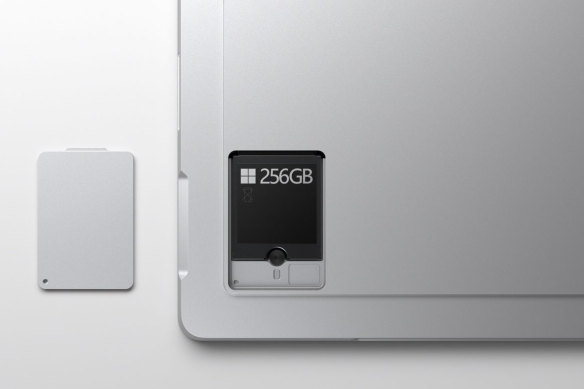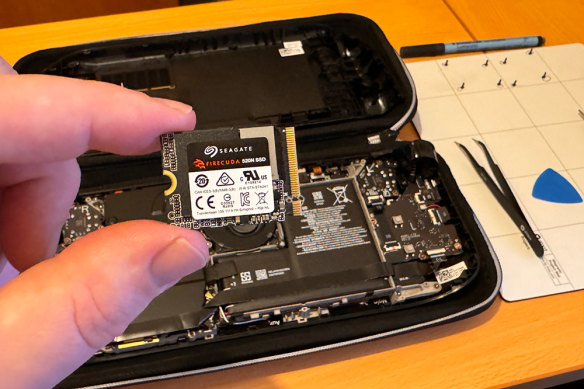This was published 5 months ago
Can you save money with BYO storage on laptops and phones?
By Tim Biggs
When buying a new phone, laptop, tablet or other device, you are often presented with a number of options, depending on how much storage space you need. But with the price of storage continually falling, can you get away with spending less and installing your own solution?
The answer, as is often the case, is that it depends. Those looking at iPhones and iPads are more or less out of luck, as Apple only allows limited functions with attached external storage. However, for other devices, you can save hundreds of dollars by sourcing your own cards, sticks or solid-state drives (SSDs).

Some laptops have easily accessible SSDs. Always check your device’s requirements before buying a new one.
SD Cards and USB drives
Generally speaking, these kinds of storage devices are designed to be portable and move between devices but, in some cases, you can use them to permanently expand your storage space. For example, on a new MacBook Air, the difference between a 256 gigabyte model and a 1 terabyte model is $600, but you can get an extremely fast USB-C drive for much less – the LaCie Rugged Mini is $300 for 1TB. Obviously, having it hanging off your laptop at all times isn’t ideal, but you could use it to install your work apps, then leave it at your desk. If you don’t need the speed and only want to store documents and such, you might only need to spend $150 for 1TB.
The same thing applies to Windows PCs where often the price difference between models is large because the ones with more storage also have more RAM or faster processors. The only thing to watch out for is that the speed of your USB-C ports can handle fast external drives. Look up your PCs specs, and they should support USB 3.2 or USB 4, or might say Thunderbolt 3 or 4.
If your device has an SD or MicroSD reader, you can easily and cheaply expand the storage. So, for example, Samsung’s Galaxy A55 smartphone only has 128GB of internal storage, which looks tiny compared to most other phones. However, a good quality 256GB card triples the storage for about $30.
At the extreme end, you could buy a 1TB card for around $150, meaning you could save a lot of money by opting for a less spacious model of MacBook Pro or Dell XPS. Keep in mind an SD card will be slower for sustained performance than the drive inside your laptop, so big transfers take longer.
Speed classifications for SD cards are extremely complicated, and most units are covered in arcane logos and specifications. But to keep things simple, your card should have either a numeral 1 or 3 inside a U-shaped bucket (which is related to the card’s speed class), or a stamp of A1 or A2 (which classifies it as being able to run apps). Just as importantly, stick to trusted sellers and known brands like SanDisk, Samsung and Kingston, as there are many dodgy SD cards.
Opening up the case
For many reasons, having a bigger SSD inside your device will be preferable to relying on USB or SD cards. Internal drives tend to be faster, are more closely integrated with your device, and they cut down on the chance you’ll lose or damage them. But devices vary considerably in terms of how easy a self-install is to do – if it’s possible at all.
Some laptops have a user-accessible SSD, where you can open a door or unscrew a flap and simply pull the drive out with your fingers. This is ideal because you can look up what kind of drive is compatible (SSDs come in several shapes and sizes, so always check), buy one with a small drive and then upgrade it. Depending on the format, some fast SSDs can be as cheap as $150 for 2TB. One obvious pick here are certain recent Microsoft Surface devices, which have accessible SSDs.

This tiny SSD increased my Steam Deck’s storage several times over.Credit: Tim Biggs
Unfortunately, accessible SSDs are becoming much less common. Many laptops can be opened with suitable screwdrivers, and many use standard parts you can replace, but if you mess something up in there, it will void your warranty. If you plan to save a few hundred dollars this way, the best bet is to look up a drive replacement tutorial for your device, see if you’d be confident making the upgrade, and make sure you understand what drives are compatible.
As an example, I recently upgraded the SSD in my Steam Deck. Valve’s portable gaming PC is not officially available in Australia but, on import sites such as Kogan, the difference between the least expensive model (LCD screen, 64GB storage) and most expensive model (OLED screen, 1TB storage) can be almost $600. The Deck takes a compact M.2 2230 drive – the same as the Surface – so, with fast and compatible options like Seagate’s 520N available for around $220 (1TB) or $400 (2TB), you can buy a less expensive model and bring it up to exceed the premium versions (minus the screen quality).
Opening the Deck required special screwdrivers and a guitar pick, and careful reading of a guide, but was otherwise easy. As with any drive swap, the main thing to worry about is data; you need to back up anything important, make sure your drive is not encrypted, and understand how you are going to install an operating system (SteamOS in this case, but it will often be Windows) once you’re done.
My installation of the 520N took a few hours of work but, if you don’t mind getting your hands dirty, it’s clear you can save a lot of money with your own SSD swap.
Get news and reviews on technology, gadgets and gaming in our Technology newsletter every Friday. Sign up here.